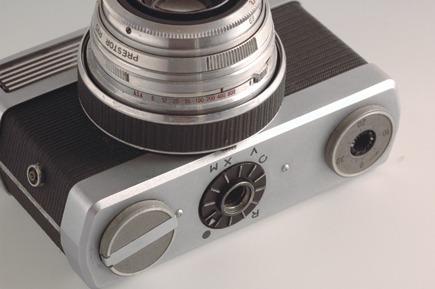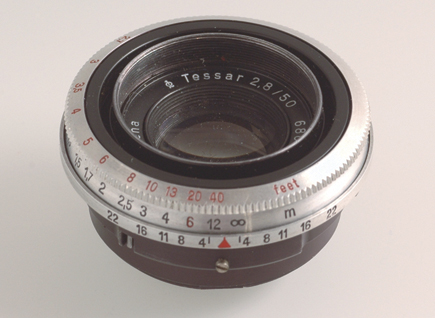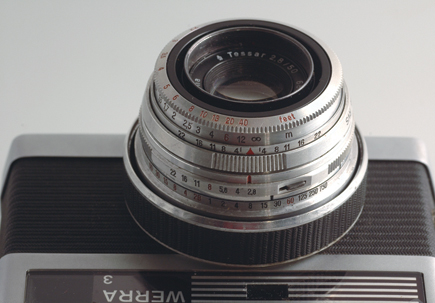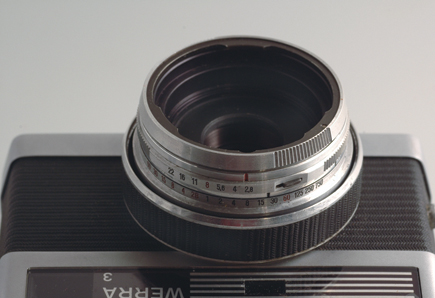In only four days, complete strangers contributed $60,000 -- far exceeding their initial $20,000 goal -- to put towards their honeymoon to Disney World. Now, the donations have totaled $66,397, shocking Keane and Carstens.
w i nxclubgames
p o i ntandclickgames
Werra; An East German Wonder Page 2
In the middle of the base plate is a massively ribbed collar around the (3⁄8”) tripod socket: an arrowhead is also cast into it. The base plate itself is marked with a “C,” an “R,” and a black spot. Again these are painted on, not engraved. The black spot is “lock”; “R” is (predictably) the rewind clutch—a cam on the inside of the collar operates a lever that disengages the wind-on sprocket—and “C” is the open position.
The third feature on the base plate is one of the worst film counters of all time: manually reset, gray-on-gray numbers, and with an all-but-illegible black-on-black rotating index mark. Most owners add a dab of paint to the index mark, which (believe it or not) is on the end of the take-up spool, poking through a hole in the bottom of the camera. To cap it all, although I’ve not had any trouble with this one yet, counters on other Werras I have owned have not always been very reliable.
 |
|
|
With all this on the bottom, there’s no need for much on top: a shutter release (with conventional tapered PC socket) and an accessory shoe: “cold,” of course. There are two windows on the front, one for the viewfinder and one for the rangefinder. The rangefinder has a very faint coincident (superimposed) image—you can really only see it when you are looking straight at a light source—and a much easier to use and very bright split image.
In the viewfinder, the whole frame is used for 35mm; there are 50mm and 100mm frames, fixed, in thin black lines; and all three frames have parallax compensation marks in the upper left-hand corner—including the all-in frame.
Loading is easy enough. At C, the whole base and back slides off as a unit. Tuck the film leader under the spring on the take-up spool. While the back is off, you can see that the tripod socket is integral with the main body casting and, like the counter, pokes through a hole in the bottom. Replace the back; set the counter to -2; and you’re ready to go.
Now, the Werra is a delightful camera to play with, as long as you are not taking pictures. Cradle it in your left hand, with the lens pointing up over your right shoulder; twist the wind-on collar with your right hand; fire the shutter with your thumb. It’s all lovely.
 |
|
|
Actually taking pictures is a bit more onerous. There’s not much of the camera to grip with your right hand: only about 17mm or 2⁄3” of flat body to the right of the cocking collar. Winding on is not the most natural or fluid movement: for me, it seems to go the wrong way, too. As you wind on, you have a choice of obscuring the finder, or shifting your grip so that your left thumb does not collide with your right-middle finger as the latter desperately tries to hang on to the camera. A left-hand grip is probably preferable, ideally in conjunction with a wrist strap; but this means taking your finger off the shutter release as you wind on, which goes against decades of practice for me. Take care to twist the collar all the way, or you can get overlapping images.
There is nothing especially difficult about any of this; it’s just odd if you are used to other cameras. As, indeed, is just about every other feature of the Werra.
The split-image-only rangefinder is nothing like as easy to use as a coincident-plus-split-image. The focusing ring is tiny and stiff: the latter is probably the result of age, but the former isn’t. The focusing is slow, at about 180? from infinity to 80cm (31.5”). The linked aperture/shutter scales are less than convenient. It is not a rapid-action camera.
Results? About what you’d expect from a 50-year-old, high-quality camera. Tessars have a wonderful reputation, but to retain good performance at f/2.8 you need some fairly fancy glasses, which were not used here.
 |
|
 |
|
|
Of course, you can get too excited about this sort of thing. By f/5.6—at which aperture (or smaller) most pictures are taken—the Werra is very good indeed, and if you are shooting at wider apertures, you are seldom concerned with test-target resolution and sharpness. In other words, like most cameras, it can take better pictures under most conditions than most photographers, but you‘d need to love it to use it. It is, perhaps, the ideal classic film camera for the habitual digital user who wants to shoot film occasionally, because it is so different from anything digital ever made.
Value? As is increasingly the case, it’s hard to say. Film cameras are perceived more and more as collectibles, and less and less as usable, and Werras are not exactly rare—though they are more common in Europe than the US, where Filthy Commie Cameras were often hard to find in the Cold War era. In the long term, I suspect that Werras will keep their value better than most, but right now, a rangefinder Werra like this would be a bargain at $35 and rather over-the-top at $100, even after allowing for the weakness of the dollar. That’s with the hood and lens cap: knock off 10-20 percent if the first is missing, 50 percent for the absence of the latter. Non-rangefinder models would normally be cheaper; with metered models, a lot would depend on the condition of the meter. But for cheap entertainment, and the occasional touch of Schadenfreude, Werras are hard to beat.
For pictures of some of the interior mechanisms of the Werra, and information on adjusting the rangefinder, as well as pictures taken with the camera, see “Reviews” on www.rogerandfrances.com. I’d like to acknowledge the help I received on www.rangefinderforum.com in getting into the camera and effecting the adjustment.
- Log in or register to post comments


Hi guys. Have just discovered this excellent site as I was searching for info on a Werra 1 I've just bought.
It's the version with the stippled leatherette rather than the herringbone leatherette, and doesn't have the Carl Zeiss icon on the plastic near the viewfinder.
I'm afraid I can't find out where to set the ISO/ASA value. I've checked the manual (on Butkus), but it doesn't seem to describe any way to set the appropriate film speed. I'm using Ektar 100 and wondering if I have to use the "sunny 16" rule.
Any help much appreciated.

































